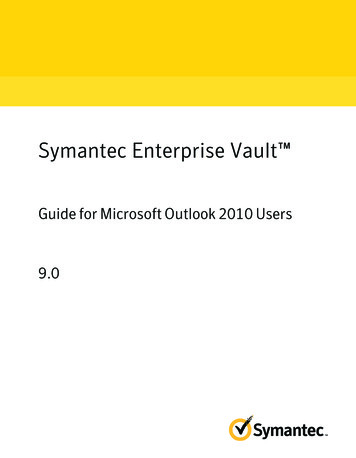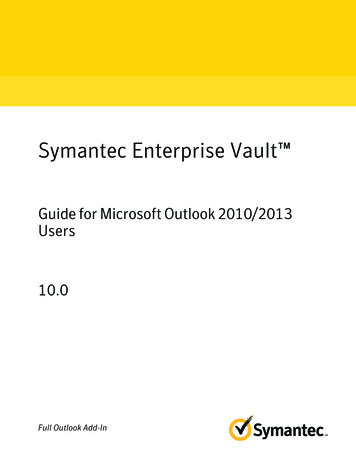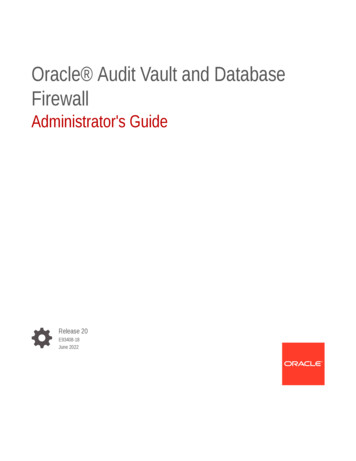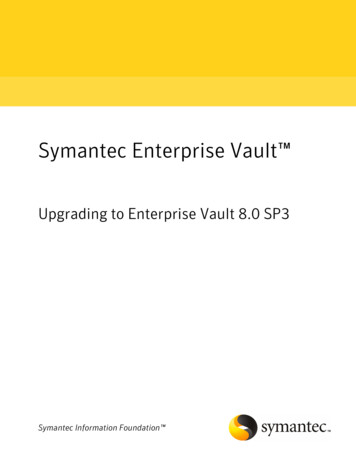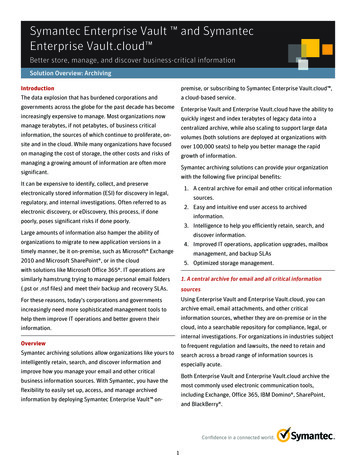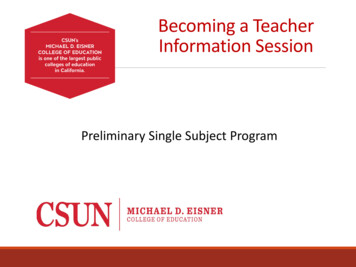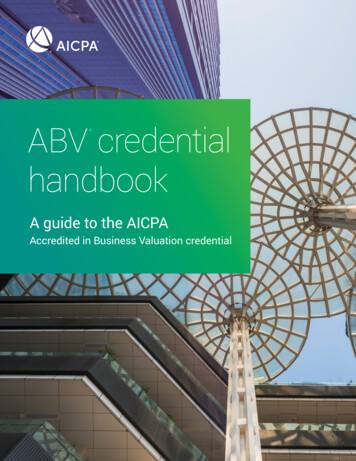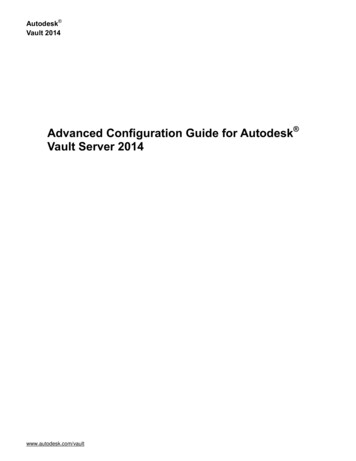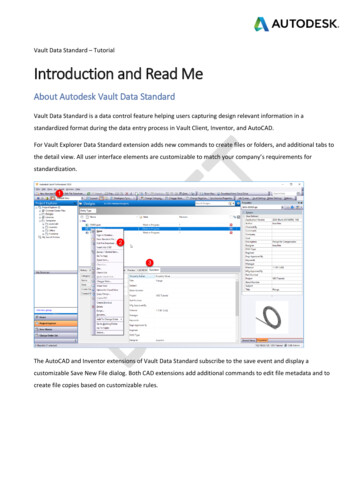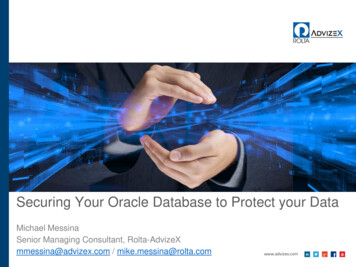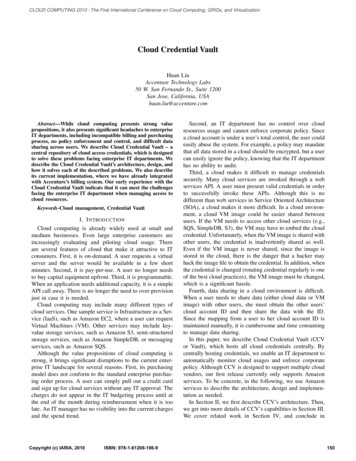
Transcription
CLOUD COMPUTING 2010 : The First International Conference on Cloud Computing, GRIDs, and VirtualizationCloud Credential VaultHuan LiuAccenture Technology Labs50 W. San Fernando St., Suite 1200San Jose, California, USAhuan.liu@accenture.comAbstract—While cloud computing presents strong valuepropositions, it also presents significant headaches to enterpriseIT departments, including incompatible billing and purchasingprocess, no policy enforcement and control, and difficult datasharing across users. We describe Cloud Credential Vault – acentral repository of cloud access credentials, which is designedto solve these problems facing enterprise IT departments. Wedescribe the Cloud Credential Vault’s architecture, design, andhow it solves each of the described problems. We also describeits current implementation, where we have already integratedwith Accenture’s billing system. Our early experience with theCloud Credential Vault indicats that it can meet the challengesfacing the enterprise IT department when managing access tocloud resources.Keywords-Cloud management, Credential VaultI. I NTRODUCTIONCloud computing is already widely used at small andmedium businesses. Even large enterprise customers areincreasingly evaluating and piloting cloud usage. Thereare several features of cloud that make it attractive to ITconsumers. First, it is on-demand. A user requests a virtualserver and the server would be available in a few shortminutes. Second, it is pay-per-use. A user no longer needsto buy capital equipment upfront. Third, it is programmable.When an application needs additional capacity, it is a simpleAPI call away. There is no longer the need to over-provisionjust in case it is needed.Cloud computing may include many different types ofcloud services. One sample service is Infrastructure as a Service (IaaS), such as Amazon EC2, where a user can requestVirtual Machines (VM). Other services may include keyvalue storage services, such as Amazon S3, semi-structuredstorage services, such as Amazon SimpleDB, or messagingservices, such as Amazon SQS.Although the value propositions of cloud computing isstrong, it brings significant disruptions to the current enterprise IT landscape for several reasons. First, its purchasingmodel does not conform to the standard enterprise purchasing order process. A user can simply pull out a credit cardand sign up for cloud services without any IT approval. Thecharges do not appear in the IT budgeting process until atthe end of the month during reimbursement when it is toolate. An IT manager has no visibility into the current chargesand the spend trend.Copyright (c) IARIA, 2010ISBN: 978-1-61208-106-9Second, an IT department has no control over cloudresources usage and cannot enforce corporate policy. Sincea cloud account is under a user’s total control, the user couldeasily abuse the system. For example, a policy may mandatethat all data stored in a cloud should be encrypted, but a usercan easily ignore the policy, knowing that the IT departmenthas no ability to audit.Third, a cloud makes it difficult to manage credentialssecurely. Many cloud services are invoked through a webservices API. A user must present valid credentials in orderto successfully invoke these APIs. Although this is nodifferent than web services in Service Oriented Architecture(SOA), a cloud makes it more difficult. In a cloud environment, a cloud VM image could be easier shared betweenusers. If the VM needs to access other cloud services (e.g.,SQS, SimpleDB, S3), the VM may have to embed the cloudcredential. Unfortunately, when the VM image is shared withother users, the credential is inadvertently shared as well.Even if the VM image is never shared, since the image isstored in the cloud, there is the danger that a hacker mayhack the image file to obtain the credential. In addition, whenthe credential is changed (rotating credential regularly is oneof the best cloud practices), the VM image must be changed,which is a significant hassle.Fourth, data sharing in a cloud environment is difficult.When a user needs to share data (either cloud data or VMimage) with other users, she must obtain the other users’cloud account ID and then share the data with the ID.Since the mapping from a user to her cloud account ID ismaintained manually, it is cumbersome and time consumingto manage data sharing.In this paper, we describe Cloud Credential Vault (CCVor Vault), which hosts all cloud credentials centrally. Bycentrally hosting credentials, we enable an IT department toautomatically monitor cloud usages and enforce corporatepolicy. Although CCV is designed to support multiple cloudvendors, our first release currently only supports Amazonservices. To be concrete, in the following, we use Amazonservices to describe the architecture, design and implementation as needed.In Section II, we first describe CCV’s architecture. Then,we get into more details of CCV’s capabilities in Section III.We cover related work in Section IV, and conclude in150
CLOUD COMPUTING 2010 : The First International Conference on Cloud Computing, GRIDs, and VirtualizationCloud portalLDAP directoryCloud portalVaultProxy portalaccessConsult for verification1. sign up or sign inSign in with Enterprise ID2. request API credential3. access cloud APICloud access pointFigure 1.Cloud access model.Only grant API credentialAccess with APIcredentialCloud access pointSection V.Figure 2.CCV architecture.II. VAULT ARCHITECTUREIn this section, we describe CCV’s architecture.A. Cloud access modelCCV exploits a unique feature of the cloud access model.Since it underpins CCV’s design, we first describe the cloudaccess model, which is shown in Figure 1.To access cloud resources, a user must first sign up foran account at the cloud vendor’s portal page [1]. As part ofsigning up, the user establishes a username and passwordpair, which is used to login to the cloud portal. We refer tothe username/password pair as the master credential, sinceknowing this pair would allow a person a complete controlover the cloud account.Using the master credential, a user can login to the cloudportal to obtain an API Credential – a credential needed tomake programmatic API calls to access cloud resources. InAmazon, the API credential consists of an access key and asecret key. In GoGrid, it consists of an API key and a sharedsecret. In Rackspace, the API credential is an authorizationtoken. Although the authorization token is not obtainabledirectly from the cloud portal, a user must first login toobtain a username and an API access key, then use them tofurther obtain the authorization token through an API.Knowing the API credential is not enough to completelycontrol the cloud account. For example, it is not possibleto edit profiles and view/change the billing credit card.However, knowing the API credential is enough to accesscloud resources. Although the cloud portal (only accessiblethrough the master credential) typically consists of a GUIdashboard for accessing cloud resources, this functionalitycan be easily replicated by using the cloud APIs, which onlyrequires the API credential. There are already a large numberof third-party GUI console tools available which makesaccessing cloud resources easier. For example, ElasticFox[2] is a popular dashboard for Amazon EC2, and S3Fox [3]is a popular dashboard for Amazon S3, both only need theAPI credential (access and secret key) to function properly.Many cloud vendors, especially those with programmableAPIs, follow this access model: a master credential is usedCopyright (c) IARIA, 2010ISBN: 978-1-61208-106-9to control the overall account and an API credential is usedto access cloud resources. We exploit this separation ofcredentials in our CCV design.B. CCV architectureThe basic idea behind CCV is that we split the mastercredential and the API credential. CCV, which is under thedirect control of IT, holds the master credential so that ITcan maintain a complete control of the cloud account. Whena user is approved to have access to cloud resources, she ishanded a unique cloud account which is not shared withothers. A user is only given the API credential so that shecan access cloud resources, but she is never given the mastercredential which would have given her total control over theaccount.Figure 2 shows CCV’s architecture. CCV is a web application, for which users can access directly from their webbrowser. It integrates with an enterprise’s LDAP directory,so that it allows single sign on. Although it currently onlyworks with one administrative domain, we plan to supportsome form of federated identity, such as that described in [4].With federation, a CCV can support multiple organizations,making it possible to offer credential management as aservice.CCV interacts with the cloud portal directly. Since a userno longer has access to the master credential, she no longercan perform some functions that she is able to do throughthe cloud portal. Besides not being able to download theAPI credential, a user may not be able to perform otherfunctions, e.g., downloading billing statements in the caseof Amazon. CCV replicates those functions so that the userstill have access to the same information. For Amazon, wescreen-scrap the portal page in order to download all billingstatements. From the cloud portal, a user could also performfunctions that change account settings, such as changing thebilling credit card number. Since we do not want the usersto view or make those changes, we do not replicate thosefunctions in CCV.151
CLOUD COMPUTING 2010 : The First International Conference on Cloud Computing, GRIDs, and VirtualizationMySQL databaseTomcatServletBrowserBackendprocessFigure 3.CCV implementation architecture.Even though not shown, CCV is designed to supportmultiple cloud providers. In the back end, CCV not onlyholds the credentials for multiple cloud providers, but it alsointeracts with each of the cloud portals. For users, CCVcan supply cloud accounts from multiple cloud vendors,depending on what a user requests.A user of CCV can login to CCV to perform functions thatshe normally would use the cloud portal to perform, such asdownloading the API credential, or viewing her cloud usage.Once the user has the API credential, she can access cloudresources directly through the cloud access point using thirdparty tools. Since only the infrequent action (e.g., viewingstatement once a month), but not the more frequent actionof accessing cloud resources, goes through CCV, CCV isunlikely to be a performance bottleneck.Figure 3 shows the current implementation architecture.We use Google Web Toolkit (GWT) to develop the front endbrowser UI. The backend is implemented as Java Servletrunning in a Tomcat container. The backend servlet isresponsible for communicating with the frontend througha RPC mechanism. When the frontend invokes RPC calls toretrieve information, the servlet checks (and authenticate ifnecessary) the user’s identity, and then returns the appropriate information authorized for the user.There is a separate backend process running on the sameserver. It performs bulk actions that are not part of theweb UI’s request/response exchange. For example, oncea month, the backend process logs into the cloud portal,screen-scraps and downloads the billing statement for eachaccount. In our current implementation, downloading thecomplete billing statement at Amazon for one account takesroughly 30 seconds, thus it is not suitable to download ondemand when a user requests it. When a user requests fora billing statement that has not been downloaded yet, theservlet passes a request to the backend process, and it thenreturns immediately. The user is notified that the statementis being updated and that she should wait for a short whilebefore viewing it again.Screen-scraping simulates a user accessing for information, and a program automatically parses the output forneeded information [5]. There are various ways to screen-Copyright (c) IARIA, 2010ISBN: 978-1-61208-106-9scrap. For example, we could use the accessibility layer ofan operating system to access UI components[6]. However,since all cloud vendors provide a web portal, we choose touse HtmlUnit[7] to parse the returned web page for relevantinformation.Besides downloading billing statements, the backend process also performs auditing and policy enforcement. Forexample, if a policy states that no cloud data should be unencrypted, the backend process periodically takes a sample,and checks if any file conforms to the corporate policy. SinceCCV not only has the master credential, but also the APIcredential, it can easily invoke cloud API to perform theauditing. Section III-B describes the kind of policies thatwe currently support.Information downloaded from the cloud portal, such as thebilling statement and the credentials, are stored in a MySQLdatabase. For security purpose, all credentials are encryptedbefore stored in the database. The servlet does not keep anybilling or credential data in memory. It always queries thedatabase for the latest information. Thus, the database is ourcentral state storage, which simplifies the synchronizationbetween the servlet and the backend process.III. S OLUTIONDETAILSThis section describes the CCV solution in details. Inparticular, we describe how we address each of the problemsdescribed in Section I.A. Billing integrationOne of the goals of CCV is to integrate with an enterprise’s internal billing process. CCV accomplishes this goalby acting as a broker between the internal billing systemand the cloud.In the cloud portal, CCV configures each cloud accountto use a corporate credit card, which is charged each monthby the cloud vendor and then paid directly by the ITdepartment. In Amazon, we enable consolidated billing forall cloud accounts under CCV’s management. This allowsus to benefit from volume discount.When a user signs up for a cloud account in CCV, shemust configures a charge code associated with the cloudaccount. The charge code is charged each month for theactual cloud usage. In Accenture, the charge code is referredto as the WBS element. Although each company has adifferent internal billing mechanism, we have designed CCVto be flexible enough that it can easily integrate with adifferent mechanism.When a charge code owner logs into CCV, she can see allcloud accounts that are charging to her charge code. She canview billing statements for all those cloud accounts. SinceCCV can download partial billing statement when a user orthe charge code owner requests, even if it is not the end ofthe month yet, the charge code owner can view up-to-datespends.152
CLOUD COMPUTING 2010 : The First International Conference on Cloud Computing, GRIDs, and VirtualizationB. Control and policy enforcementThe charge code owner has a full control over the cloudaccount. She can optionally disable an account (e.g., if theuser abuses the account or if the user has left the company),in which case, the API credential is changed so that the usercan no longer use it. In addition, the charge code owner canoptionally stop all cloud resources usage (stop all serversand/or remove all storage) to stop incurring further charges.We also plan to support a flexible set of policies thata charge code owner can specify and enforce. However,initially we only support two sample policies.The first policy states that “no more than 𝑥 servers arerunning each day at time 𝑦”. Both 𝑥 (a number) and 𝑦 (atime) are specified by the charge code owner. This policyis designed to catch run-away instances – instances that theuser forgot to turn off, which happens frequently in the cloudenvironment. When enforcing this policy, we start a cron jobat the specified time 𝑦 and use the API credential to queryhow many EC2 servers are running at the time. If it is morethan 𝑥, we send an email alert to the charge code owner.The second policy states that “all cloud data should beencrypted”. When this policy is enabled, CCV periodicallysamples a few files stored in the cloud, and checks whetherthey are encrypted. For demonstration purpose, we currentlyonly check whether the file is a plain text file. However,in the future, we intend to employ more sophisticatedalgorithms to detect whether a file is encrypted.While these two policies are designed to demonstrate thecapabilities of CCV, we intend to support a wider rangeof flexible policies. We are in the process of gatheringrequirements to understand which set of policies are the mostuseful.C. Credential on demandWhen a VM needs to access other cloud resources, suchas S3, SQS and SimpleDB, a common practice today is toembed the needed API credential inside the VM image. Thereason is because it is cumbersome to copy over the APIcredential every time the VM starts. However, this practiceis not secure, for two reasons.First, the server image could be shared with other cloudusers. When other cloud users launch the same image, theywould have access to the image owner’s API credential.Second, changing API credential frequently is a cloudbest practice, since it minimizes the damage of losing anAPI credential. Unfortunately, when the API credential ischanged, the credential embedded in the VM images remainsthe same, requiring the image to be recreated again.Instead of embedding the image creator’s API credential,we believe a VM should be entitled to the image user’s APIcredential. CCV provides such a facility to VMs to query theAPI credential used to launch the VMs in the first place. TheVM can request this by querying a URL at the IP addressCopyright (c) IARIA, 2010ISBN: 978-1-61208-106-9of CCV, but with URI of “/apicredential”, e.g., a VM canquery https://ccv.com/apicredential.When a VM queries this API, CCV first has to find theAPI credential used to launch the VM. We currently iterateover each stored API credential and query Amazon API insequence to see which API credential the VM was launchedunder. Although this is inefficient, we have not run intoperformance problems yet during our pilot trial. We areactively looking into alternative approach to determine thelaunching credential,When the launching API credential is found, CCV passesback the API credential to the VM, so that is can start accessing other cloud services such as S3, SimpleDB, and SQS. Byproviding this mechanism of API credential on demand, weprevent any need to hard-code credential information insidea VM image, thus greatly enhance cloud security.D. Data sharingSharing data across cloud account is cumbersome. A userhas to find out about other users’ cloud account ID (a 12digits number in Amazon) and enables sharing with the IDinstead of a user name.In CCV, a user can share cloud data and server imageswith a user name or a group alias. The group aliases are fromthe LDAP directory. When a user chooses to share with agroup (e.g., HR.global group), CCV looks up in the LDAPdirectory to expand the group into a list of user names. Fromthe list of user names, CCV then expands it into a list ofcloud account IDs by checking the cloud account IDs thatbelong to each user. It then shares the data or image with thelist of account IDs. Even though CCV still uses the cloud’snative capability to share data with an account ID, the useroperates at a much higher abstraction layer, sharing with auser or a group of users.The group membership in LDAP directory may changeover time, e.g., new members joining HR.global or existingmembers leaving HR.global. CCV periodically checks thegroup membership and adjusts the permission as needed.IV. R ELATED WORKRightScale[8] and EnStratus[8] all address the same management challenge facing enterprises trying to adopt cloudcomputing. However, both of them take a different approachthan ours. They use one cloud account to support a wholeenterprise, and build an interface on top to multiplex multiplecloud users through the same cloud account. Although it hasthe ability to limit a user to a subset of cloud functionalities,it has two disadvantages. First, their interfaces have tobe very scalable since all cloud access go through thoseinterfaces. Second, they cannot perform accurate accountingbetween different projects. For example, a VM could consume significant bandwidth charges, but since its bandwidthusage does not go through the management interfaces, it is153
CLOUD COMPUTING 2010 : The First International Conference on Cloud Computing, GRIDs, and Virtualizationnot possible for those interfaces to meter and bill projectsfor those bandwidth charges.MyProxy[9][10] is a repository of X.509 proxycertificates[11]. CredEx [12] extends MyProxy to furthersupport heterogeneous authentication methods. These repositories all treat the credentials as opaque, whereas we takeadvantages of the API credentials to enable control andauditing.Amazon cloud manages SSH public key in a similarmechanism as we used for passing the API credential to animage. The SSH public key is available at a fixed IP address(169.254.169.254) and a fixed URI (/latest/meta-data/publickeys). To pass the API credential, we also use a fixed IPaddress (CCV’s IP address) and a fixed URI (/apicredential).V. C ONCLUSIONAND FUTURE WORKWe have presented the architecture, design and implementation of the Cloud Credential Vault – a central repositoryof cloud credentials. By centralizing the credentials and byseparating the master credential from the API credential,CCV solves many management problems facing enterprisesthat are adopting cloud computing.We have only completed a prototype implementation supporting only one cloud vendor (Amazon). Beyond supportingmore cloud vendors, there are also several open questionsthat we need to address to make CCV more efficient. First,we need a more efficient mechanism to look up the APIcredential used to launch a particular VM. Second, weneed to define a more comprehensive set of policies tosupport. Third, we are also looking at more efficient waysto monitor group membership changes so that we can adjustdata sharing permission as needed.R EFERENCES[1] Amazon Web Services, “Amazon Web Services Portal,”http://aws.amazon.com, 08.23.2010.[2] cts/elasticfox,[3] Suchi Software, “S3fox,” http://www.s3fox.net/, 08.23.2010.[4] E. R. Mello, M. S. Wangham, J. Silva Fraga, E. T. Camargo,and D. Silva Böger, “A model for authentication credentialstranslation in service oriented architecture,” pp. 68–86, 2009.[5] B. Myers, “User interface software technology,” ACM Comput. Surv., vol. 28, no. 1, pp. 189–191, 1996.[6] M. Grechanik, K. Conroy, and K. S. Swaminathan, “Creatingweb services from gui-based applications,” in Proc. SOCA,2007.[7] Htmlunit, http://htmlunit.sourceforge.net, 08.23.2010.[8] Rightscale, http://www.rightscale.com, 08.23.2010.[9] J. Novotny, “An online credential repository for the grid:Myproxy,” in Proceedings of the Tenth International Symposium on High Performance Distributed Computing (HPDC10), IEEE. Press, 2001, pp. 104–111.[10] J. Basney, M. Humphrey, and V. Welch, “The myproxy onlinecredential repository,” Software: Practice and Experience,vol. 35, pp. 801–816, 2005.[11] S. Tuecke, V. Welch, D. Engert, L. Pearlman, andM. Thompson, “Internet X.509 public key infrastructure(PKI) proxy certificate profile.” RFC 3820 (Informational),2004. [Online]. Available: http://www.ietf.org/rfc/rfc3820.txt[12] D. D. Vecchio, M. Humphrey, J. Basney, and N. Nagaratnam,“Credex: User-centric credential management for grid andweb services,” Web Services, IEEE International Conferenceon, vol. 0, pp. 149–156, 2005.Copyright (c) IARIA, 2010ISBN: 978-1-61208-106-9154
Cloud Credential Vault indicats that it can meet the challen ges facing the enterprise IT department when managing access to cloud resources. Keywords -Cloud management, Credential Vault I. INTRODUCTION Cloud computing is already widely used at small and medium businesses. Even large enterprise customers are increasingly evaluating and piloting cloud usage. There are several features of cloud .
